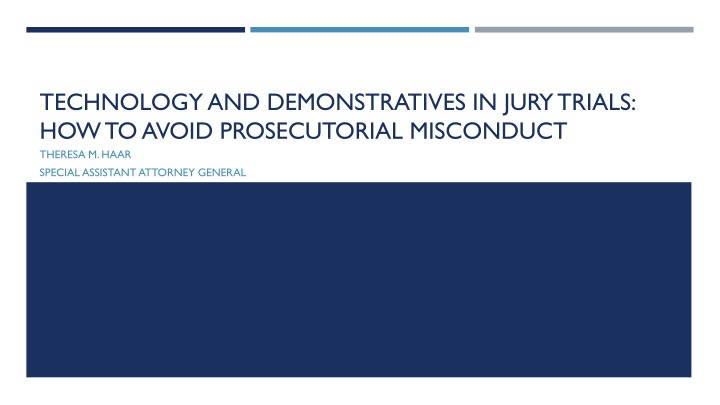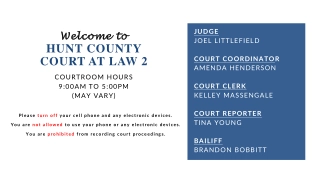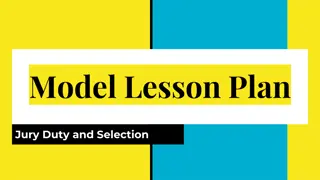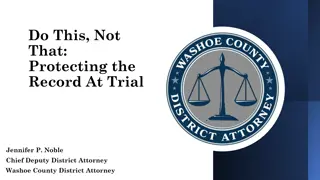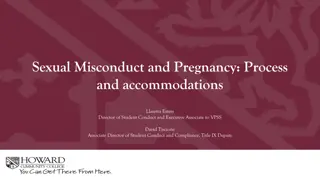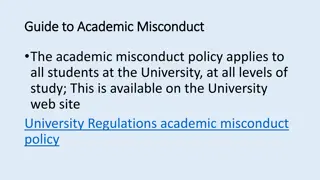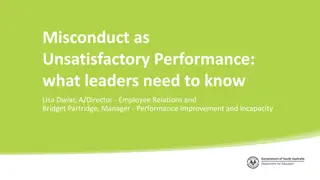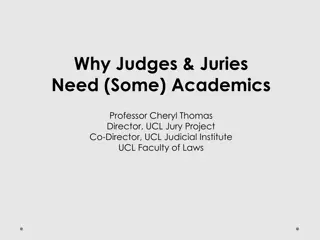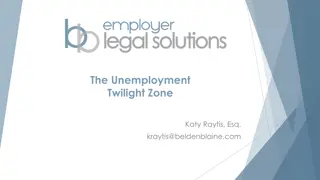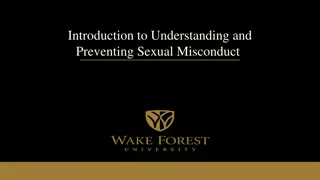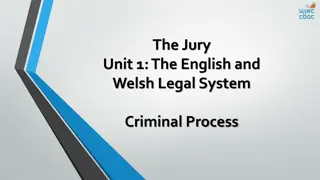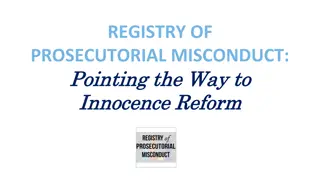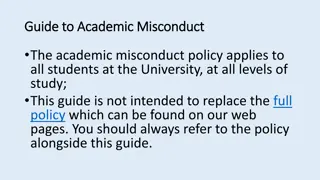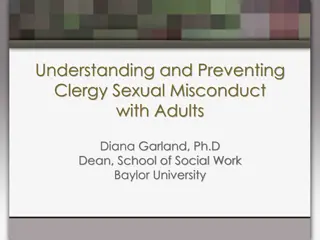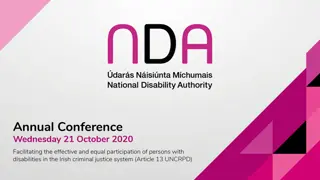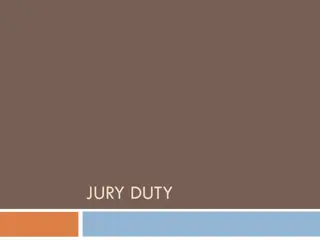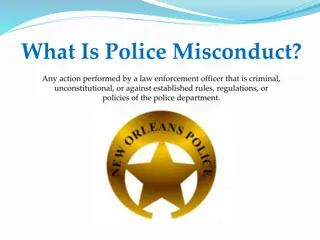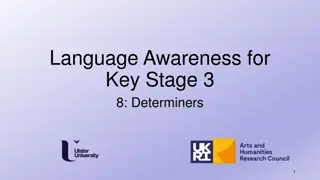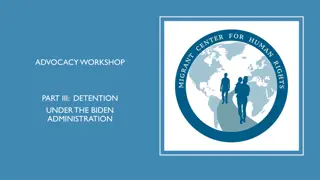Technology and Demonstratives in Jury Trials: Avoiding Prosecutorial Misconduct
Understanding prosecutorial misconduct in jury trials is crucial to maintaining fairness in the legal system. This article highlights the responsibilities of a prosecutor, the impact of misconduct, and ways to prevent it using technology and demonstratives. By following ethical guidelines and ensuring transparency, prosecutors can enhance the integrity of the judicial process.
Download Presentation

Please find below an Image/Link to download the presentation.
The content on the website is provided AS IS for your information and personal use only. It may not be sold, licensed, or shared on other websites without obtaining consent from the author.If you encounter any issues during the download, it is possible that the publisher has removed the file from their server.
You are allowed to download the files provided on this website for personal or commercial use, subject to the condition that they are used lawfully. All files are the property of their respective owners.
The content on the website is provided AS IS for your information and personal use only. It may not be sold, licensed, or shared on other websites without obtaining consent from the author.
E N D
Presentation Transcript
TECHNOLOGY AND DEMONSTRATIVES IN JURY TRIALS: HOW TO AVOID PROSECUTORIAL MISCONDUCT THERESA M. HAAR SPECIAL ASSISTANT ATTORNEY GENERAL
DUTIES OF A PROSECUTOR WHAT IS PROSECUTORIAL MISCONDUCT?
Prosecutorial misconduct is overstepp[ing] the bounds of that propriety and fairness which should characterize the conduct of such an officer in the prosecution of a criminal offense. BERGER V. UNITED STATES 285 U.S. 78 (1935)
Prosecutorial misconduct is a burden to the judicial system that is totally unnecessary and, so far as the prosecution is concerned, often self-defeating. COLLIER V. STATE 101 Nev. 473, 477, 705 P.2d 1126, 1128 (1985)
The prosecutor in a criminal case shall: (a) Refrain from prosecuting a charge that the prosecutor knows is not supported by probable cause; NEVADA RULE OF PROFESSIONAL CONDUCT 3.8 Special Responsibilities of a Prosecutor
The prosecutor in a criminal case shall: (b) Make reasonable efforts to assure that the accused has been advised of the right to, and the procedure for obtaining, counsel and has been given reasonable opportunity to obtain counsel; NEVADA RULE OF PROFESSIONAL CONDUCT 3.8 Special Responsibilities of a Prosecutor
The prosecutor in a criminal case shall: (c) Not seek to obtain from an unrepresented accused a waiver of important pretrial rights, such as the right to a preliminary hearing; NEVADA RULE OF PROFESSIONAL CONDUCT 3.8 Special Responsibilities of a Prosecutor
The prosecutor in a criminal case shall: (d) Make timely disclosure to the defense of all evidence or information known to the prosecutor that tends to negate the guilt of the accused or mitigates the offense, and, in connection with sentencing, disclose to the defense and to the tribunal all unprivileged mitigating information known to the prosecutor, except when the prosecutor is relieved of this responsibility by a protective order of the tribunal; NEVADA RULE OF PROFESSIONAL CONDUCT 3.8 Special Responsibilities of a Prosecutor
The prosecutor in a criminal case shall: (e) Not subpoena a lawyer in a grand jury or other criminal proceeding to present evidence about a past or present client unless the prosecutor reasonably believes: (1) The information sought is not protected from disclosure by any applicable privilege; (2) The evidence sought is essential to the successful completion of an ongoing investigation or prosecution; and (3) There is no other feasible alternative to obtain the information; NEVADA RULE OF PROFESSIONAL CONDUCT 3.8 Special Responsibilities of a Prosecutor
The prosecutor in a criminal case shall: (f) Except for statements that are necessary to inform the public of the nature and extent of the prosecutor s action and that serve a legitimate law enforcement purpose, refrain from making extrajudicial comments that have a substantial likelihood of heightening public condemnation of the accused and exercise reasonable care to prevent investigators, law enforcement personnel, employees or other persons assisting or associated with the prosecutor in a criminal case from making an extrajudicial statement that the prosecutor would be prohibited from making under Rule 3.6 or this Rule. NEVADA RULE OF PROFESSIONAL CONDUCT 3.8 Special Responsibilities of a Prosecutor
Nevada follows the two-step analysis of US v. Harlow First, the Court determines whether the prosecutor s conduct was improper. Second, if the conduct was improper, the Court must determine whether the improper conduct warrants reversal. With respect to the second step, the Court will not reverse a conviction based on prosecutorial misconduct if it was harmless error. US V. HARLOW 444 F.3d 1255, 1265 (10th Cir. 2006)
VALDEZ V. STATE 124 NEV. 1172, 196 P.3D 465 (2008)
Valdez was convicted of first degree murder with a deadly weapon and attempted murder with a deadly weapon. While the guilt and penalty phases were separate trials, when the jury returned the guilty verdict, it also announced that it had decided his sentence as well. Valdez stipulated to two consecutive life sentences on the murder, and two consecutive terms of 96-240 months on the attempted murder. He reserved his right to appeal the judgment of conviction. In his appeal, Valdez raised multiple arguments regarding the invalidity of his conviction and sentence. He specifically raised multiple claims of prosecutorial misconduct. 124 Nev. 1172, 196 P.3d 465 (2008) VALDEZ V. STATE
Jury Selection Okay. Well, I don't think anybody in here, with maybe one exception, would ever think that they should kill kids. 124 Nev. 1172, 196 P.3d 465 (2008) VALDEZ V. STATE
Opening Statement On that same day, there was a lot of press in this case because a little boy that's 12 years old got stabbed in the chest and he ran out of the apartment. He had a broken piece of the knife stuck in his chest still, and there was a little bit of a man hunt type of thing, so it was in the press. Eventually, he is the one that was apprehended. 124 Nev. 1172, 196 P.3d 465 (2008) VALDEZ V. STATE
Description of possible punishments There s two other charges here: Attempt murder and assault with a deadly weapon. In the event you find him guilty of that, you would not be sentencing him on that. The Court decides that. So those four punishments are the range that you would be determining, and as we ve kind of alluded to, we have to prove an aggravator or multiple aggravators that are statutorily required. There are a lot of first-degree murders out there that we ll never ever have the opportunity for the death sentence, and the reason why is because there s no aggravators. 124 Nev. 1172, 196 P.3d 465 (2008) VALDEZ V. STATE
Questioning of an expert witness The district court prohibited any suggestion that the defense prevented the State's expert witness, forensic psychiatrist Dr. Thomas Bittker, from interviewing Valdez. 124 Nev. 1172, 196 P.3d 465 (2008) VALDEZ V. STATE
Closing argument Valdez challenges the prosecutor's statement commenting on the defense's theory that S.E. stabbed Valdez in the hand, that [y]ou know what, he should have got a knife and he should have stabbed it right into the back of The defense objected that the comment was inflammatory and should be stricken. The district court sustained the objection, ordered the comment stricken, and instructed the jury to disregard it. 124 Nev. 1172, 196 P.3d 465 (2008) VALDEZ V. STATE
Cumulative Error When evaluating a claim of cumulative error, the Court must consider the following factors: (1) whether the issue of guilt is close, (2) the quantity and character of the error, and (3) the gravity of the crime charged. 124 Nev. 1172, 196 P.3d 465 (2008) VALDEZ V. STATE
Holding: A reasonable juror could have inferred from all of these comments that Valdez resisted arrest, felt no remorse for harming the child, and should be put to death to compensate for all the other first-degree murderers who will never be put to death. 124 Nev. 1172, 196 P.3d 465 (2008) VALDEZ V. STATE
ALLRED V. STATE 120 NEV. 410, 92 P.3D 1246 (2004)
Demonstrative aides are generally permissible in jury trials ALLRED V. STATE 120 Nev. 410, 92 P.3d 1246 (2004)
This case arose out of a bar fight that took place outside of the Liberty Club in Ely. The defendant claimed that he followed the victim outside to smooth things over after an argument, the victim attempted to punch him, and in response he punched the victim once. Following a 2 day trial, a jury unanimously convicted appellant Christopher Allred of one count of battery with substantial bodily harm. The district court imposed on Allred the maximum sentence of 60 months with the possibility of parole after 24 months. 120 Nev. 410, 92 P.3d 1246 (2004) ALLRED V. STATE
The defense raised on appeal that the prosecutors statements during closing arguments amounted to misconduct, particularly in commenting on the defendant s failure to testify. The Nevada Supreme Court has held that as long as a prosecutor's remarks do not call attention to a defendant's failure to testify, it is permissible to comment on the failure of the defense to counter or explain evidence presented. 120 Nev. 410, 92 P.3d 1246 (2004) ALLRED V. STATE
The defendant also argued that the prosecutors demonstrative exhibits used during closing arguments constituted misconduct because the exhibits were irrelevant, highly prejudicial, and not supported by the evidence. 120 Nev. 410, 92 P.3d 1246 (2004) ALLRED V. STATE
The district court reviewed the State's three proposed demonstrative exhibits outside the presence of the jury. The first exhibit included an admitted photograph of the victim s hands, with the notation physical evidence of a battery, and listed the injuries the victim sustained during the altercation. The second exhibit included an admitted photograph of the victim s face, with the physical evidence of a battery notation and contained check marks for his facial injuries. The third exhibit listed the injuries the victim suffered on the rest of his body. 120 Nev. 410, 92 P.3d 1246 (2004) ALLRED V. STATE
The district court sustained the objection by the defendants counsel, finding: The notations, physical evidence of a battery, were argumentative and ordered the prosecutor to remove them from the three exhibits. The third exhibit must be altered to properly reflect the victim s injuries. The prosecutor must remove the notation post battery injuries from the third exhibit, as well as the comparison between the defendant s injuries to the victim s injuries. 120 Nev. 410, 92 P.3d 1246 (2004) ALLRED V. STATE
The use of demonstrative aides is appropriate so long as the aides do not misrepresent the evidence introduced at trial. It is important to remember that a demonstrative may not be used to make an argument visually that would be improper if made orally. 120 Nev. 410, 92 P.3d 1246 (2004) ALLRED V. STATE
In utilizing PowerPoint presentations, prosecutors should always ensure that their presentations: Contain only images that have been admitted into evidence during the trial; Contain unaltered images; Provide information which merely summarizes evidence presented; Do not demonstrate the prosecutor s personal opinion; Do not have language that obviates the presumption of innocence; and Do not misstate the applicable law
Some common bases for misconduct in using PowerPoint presentations Oversimplification of legal instructions Insertion of a prosecutor s personal opinion Inclusion of materials not in evidence Improper comments on a defendant s constitutional rights
WATTERS V. STATE 129 NEV. 886, 313 P.3D 243 (2013)
Frankie Alan Watters was charged with and convicted of possession of a stolen vehicle, grand larceny of a vehicle, and failure to stop on the signal of a police officer. The charges grew out of a crime spree in which Watters allegedly stole a car, got in a wreck, fled, stole another car, became involved in a high- speed chase, ditched the second car, ran into a store, and was finally arrested after being knocked to the ground and bitten several times in the leg by a police dog. 129 Nev. 886, 313 P.3d 243 (2013) WATTERS V. STATE
At trial, the State used a PowerPoint to support its opening statement to the jury. The presentation included a slide showing the defendant s booking photo with the word GUILTY written across his battered face. 129 Nev. 886, 313 P.3d 243 (2013) WATTERS V. STATE
Opening Statements The purpose of the opening statement is to acquaint the jury and the court with the nature of the case. In a criminal case, the prosecutor's opening statement should be confined to a statement of the issues in the case and the evidence the prosecutor intends to offer which the prosecutor believes in good faith will be available and admissible. It is not an opportunity to poison the jury's mind against the defendant or to recite items of highly questionable evidence. 129 Nev. 886, 313 P.3d 243 (2013) WATTERS V. STATE
A prosecutor may use PowerPoint slides to support his or her opening statement so long as the slides' content is consistent with the scope and purpose of opening statements and does not put inadmissible evidence or improper argument before the jury. But a PowerPoint may not be used to make an argument visually that would be improper if made orally. 129 Nev. 886, 313 P.3d 243 (2013) WATTERS V. STATE
The prosecution could not orally declare the defendant guilty in opening statement. Doing so would amount to improper argument and the expression of personal opinion on the defendant's guilt, which is forbidden. See Collier v. State, 101 Nev. 473, 480, 705 P.2d 1126, 1130 (1985) (a prosecutor should not express her personal opinion on the defendant's guilt; [b]y stepping out of the prosecutor's role, which is to seek justice, and by invoking the authority of ... her own supposedly greater experience and knowledge, a prosecutor invites undue jury reliance on the conclusions personally endorsed by the prosecuting attorney ). 129 Nev. 886, 313 P.3d 243 (2013) WATTERS V. STATE
In its holding, the Court stressed the impact of visual aids on a jury, [w]ith visual information, people believe what they see and will not step back and critically examine the conclusions they reach, unless they are explicitly motivated to do so. 129 Nev. 886, 313 P.3d 243 (2013) WATTERS V. STATE
STATE V. SALAS 408 P.3D 383 (WASH. CT. APP. 2018)
Encarnacion Salas was charged with the second degree murder of an individual who was described in court as Salas good friend. Salas claimed self-defense. 408 P.3d 383 (Wash. Ct. App. 2018) STATE V. SALAS
At closing, the prosecutor displayed a 22-slide PowerPoint presentation, which had not been previously shared with the court or with the defendant s counsel. 408 P.3d 383 (Wash. Ct. App. 2018) STATE V. SALAS
The first slide contained two pictures. The picture on the right was a picture of Lopez at an amusement park. He was photographed crouched down in front of three characters dressed as Smurfs. A caption about the photo reads, Jesse Lopez: 5 5.5 , Band leader, saxophone player, customer service representative. The second picture is an unsmiling picture of Salas from his driver s license. It is captioned EJ Salas: 5 11 , Football player, fighter, outdoorsman. The prosecutor claimed this was in an attempt to defeat the self-defense claim by highlighting the differences between the physical capabilities of the defendant and the deceased. However, the prosecutor also failed to note that the two men weighed approximately the same. 408 P.3d 383 (Wash. Ct. App. 2018) STATE V. SALAS
Closing argument provides an opportunity for counsel to summarize and highlight relevant evidence and argue reasonable inferences from the evidence. PowerPoint slides can be improper and prejudicial even if they do not number in the hundreds and do not shout GUILTY GUILTY GUILTY! in red letters. The Washington Court concluded there was a substantial likelihood that the visual presentation prejudiced the defendant s right to a trial in which his claim of self-defense and the alternative of manslaughter could be fairly considered, and ordered a new trial. 408 P.3d 383 (Wash. Ct. App. 2018) STATE V. SALAS
STATE V. WALKER 341 P.3D 976 (WASH. 2015)
